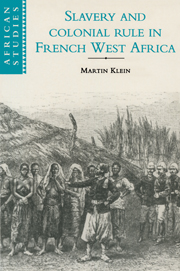Book contents
- Frontmatter
- Contents
- List of illustrations
- List of maps
- List of tables
- Preface
- List of abbreviations
- Glossary
- 1 Slavery in the Western Sudan
- 2 Abolition and retreat. Senegal 1848–1876
- 3 Slavery, slave-trading and social revolution
- 4 Senegal after Brière
- 5 Conquest of the Sudan: Desbordes to Archinard
- 6 Senegal in the 1890s
- 7 The end of the conquest
- 8 The imposition of metropolitan priorities on slavery
- 9 With smoke and mirrors: slavery and the conquest of Guinea
- 10 The Banamba Exodus
- 11 French fears and the limits to an emancipation policy
- 12 Looking for the tracks. How they did it
- 13 After the War: renegotiating social relations
- 14 A question of honor
- Appendixes
- Notes
- Bibliography
- Index
- Titles in the series
1 - Slavery in the Western Sudan
Published online by Cambridge University Press: 07 May 2010
- Frontmatter
- Contents
- List of illustrations
- List of maps
- List of tables
- Preface
- List of abbreviations
- Glossary
- 1 Slavery in the Western Sudan
- 2 Abolition and retreat. Senegal 1848–1876
- 3 Slavery, slave-trading and social revolution
- 4 Senegal after Brière
- 5 Conquest of the Sudan: Desbordes to Archinard
- 6 Senegal in the 1890s
- 7 The end of the conquest
- 8 The imposition of metropolitan priorities on slavery
- 9 With smoke and mirrors: slavery and the conquest of Guinea
- 10 The Banamba Exodus
- 11 French fears and the limits to an emancipation policy
- 12 Looking for the tracks. How they did it
- 13 After the War: renegotiating social relations
- 14 A question of honor
- Appendixes
- Notes
- Bibliography
- Index
- Titles in the series
Summary
… in order to be exploited, the “alien” is rendered incapable of reproducing socially as a distinct social category.
Meillassoux 1986 (1991): 36Not only was the slave denied all claims on, and obligations to his parents and living blood relations, but by extension, all such claims and obligations on his more remote ancestors and on his descendants. He was truly a genealogical isolate.
Patterson 1982: 5The Sudan is a broad belt of grassland that stretches across the West African continent. The word comes from the Arabic Bilad es Sudan, “the land of the Blacks.” The Sudan's northern fringe, the Sahel, merges into the desert and has long been influenced by exchange with desert peoples. To the south, it merges with woodland and forest and with mountainous areas like the Futa Jallon of Guinea. Of all areas of Africa, it is the one that has seen the longest development of agriculture, of markets and long-distance trade, and of complex political systems. It was also the first area south of the Sahara where African Islam took root and flowered. This study is concerned with three former French colonies: Senegal, Guinea and the agricultural part of Mali.
For much of modern history, the western Sudan has been a source of slaves for other parts of the world. Early in the first millennium, it began providing a steady stream of slaves for the Mediterranean world and, with the coming of the Portuguese in the fifteenth century, people were directed into the Atlantic slave trade.
- Type
- Chapter
- Information
- Slavery and Colonial Rule in French West Africa , pp. 1 - 18Publisher: Cambridge University PressPrint publication year: 1998



